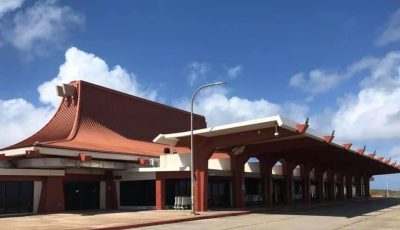Fitch affirms CNMI Seaport Revs at ‘BB’; outlook stable
Credit rating agency Fitch Ratings has affirmed the “BB” rating on approximately $18.3 million of outstanding Commonwealth Ports Authority, Commonwealth of the Northern Mariana Islands senior series 1998A and 2005A seaport revenue bonds. The Rating Outlook is Stable.
The rating reflects the essentiality of the ports to a small, island economy amid high exposure to economic volatility from tourism and a nearly 100% import-based cargo operation. The rating also considers CPA’s sustained revenue performance and history of controlled expenses. Despite recent adverse impacts on operational performance, CPA is expected to maintain financial metrics supportive of the current rating level. Under Fitch’s rating case scenario, coverage levels average 1.7x through the forecast period. CPA further benefits from robust liquidity levels that provide some mitigation to a prolonged softening of cargo demand.
KEY RATING DRIVERS
Concentrated but Vital Cargo Base – Revenue Risk (Volume): Weaker
The seaports remain essential for the import of goods to an island economy; however, there is potential for stagnant operational trends, due to CNMI’s exposure to macroeconomic factors, and its elevated dependence on a limited tourist base. Volume stability is expected, given that food and fuel related cargos account for approximately 50% of import-dependent revenue tonnage.
Limited Pricing Power – Revenue Risk (Price): Weaker
CNMI’s narrow economy and exposure to economic volatility limit management’s economic flexibility to raise rates on seaport system tenants and users. Following the last increase in 2009, the authority’s focus has instead been on effective containment of operating expenses.
Modest Capital Improvement Plan – Infrastructure Development & Renewal: Midrange
The ports once handled nearly twice as much cargo, and are in satisfactory condition to deal with current and forecasted demand. The authority’s capital improvement plan (CIP) is manageable and funded with grants and internally generated funds. No additional debt is anticipated in the near to medium term.
Conservative Capital Structure – Debt Structure: Stronger
The authority maintains 100% fixed-rate, fully amortizing debt with a level debt service profile and a 2031 final maturity. Structural features and reserves are sufficient and consistent with other Fitch-rated ports.
Financial Profile
CPA maintained favorable leverage and liquidity metrics offset by a modest coverage ratio of 1.4x in fiscal 2021 (unaudited). Estimated fiscal 2021 net debt-to-cash flow available for debt service is negative, reflecting cash balances exceeding debt outstanding. The CPA maintains strong balance sheet cash and reserves available for operating expenses, with days cash on hand currently exceeding 1,800. These liquidity and leverage metrics provide the CPA with some degree of flexibility to meet financial commitments in weak performing periods. Rating case coverages are expected to average 1.7x through the projection period.
RATING SENSITIVITIES
Factors that could, individually or collectively, lead to negative rating action/downgrade:
■ A severely weakened underlying service area economy that results in the seaports’ inability to maintain cargo levels at or near current levels for a sustained period;
■ Depressed debt service coverage levels resulting from declining operating revenues;
■ A shift in the seaports’ balance sheet liquidity and financial flexibility resulting from changes in operating expense management or pricing power.
Factors that could, individually or collectively, lead to positive rating action/upgrade:
■ Given the ports’ limited operating profile and significant exposure to local economic factors, positive rating migration is not anticipated at present.
BEST/WORST CASE
RATING SCENARIO
International scale credit ratings of Sovereigns, Public Finance and Infrastructure issuers have a best-case rating upgrade scenario (defined as the 99th percentile of rating transitions, measured in a positive direction) of three notches over a three-year rating horizon; and a worst-case rating downgrade scenario (defined as the 99th percentile of rating transitions, measured in a negative direction) of three notches over three years. The complete span of best- and worst-case scenario credit ratings for all rating categories ranges from ‘AAA’ to ‘D’. Best- and worst-case scenario credit ratings are based on historical performance. For more information about the methodology used to determine sector-specific best- and worst-case scenario credit ratings, visit https://www.fitchratings.com/site/re/10111579.
CREDIT UPDATE
Revenue trends have been volatile in the past few years, attributed to the reduction in inbound revenue tonnage and damage from storms such as Super Typhoon Yutu that have passed through the CNMI, and also the pandemic. While the ports are located in an island economy with exposure to tourism, CPA also has a mix of non-operating revenues (grants and interest income) to help offset declines in operating revenue.
Seaport operations at all three ports (Saipan, Tinian, and Rota) have continued throughout the pandemic. Although operations have not ceased, incoming revenue tonnage has remained depressed, resulting in a 18% decline in overall seaport revenues in estimated fiscal 2021 relative to 2019.
Total tonnage in fiscal 2021 has recovered to 80% of pre-pandemic total tonnage in fiscal 2019.
The decrease in revenue tonnage is due to the decreased shipping activity caused by the pandemic. Fitch views positively the U.S. military divert airfield project that has been contracted for the island of Tinian, which CPA expects to drive an increase in construction materials tonnage for fiscal 2022. The project is anticipated to be completed in 2025.
Coverage in fiscal 2021 is estimated at approximately 1.4x, and leverage remains negative, benefitting from strong balance sheet cash and reserves. Though coverage is expected to remain depressed over the next 1-2 years, the reductions in seaport operations and revenue are offset by stable non-operating income and a low debt service obligation of just over $3 million through 2028 before stepping down to 540k through maturity in 2031.
FINANCIAL ANALYSIS
Given that the port system has not yet returned to normal operations and recovered to historical cargo volumes due to the current operating environment, Fitch’s rating case is also considered the base case. Fiscal 2021 revenue performance is based on preliminary actual performance. The differences for each case focus on the level and speed of cargo revenue recovery starting in 2022 and through the next several years.
Fitch’s rating case reflects the budget for fiscal 2022, followed by conservative expectations of future performance thereafter. Fitch assumes revenue recovery to 95% in fiscal 2023 and a full recovery to 2019 levels by fiscal 2024, followed by low growth of 1.5% per year thereafter. Under the rating case, DSCR averages 1.7x through 2026 and 4.3x through debt maturity in 2031. The leverage profile remains negative through the projection period.
Fitch’s downside case reflects a prolonged recovery back to 2019 levels. Revenues are expected to recover to 80% in fiscal 2022, 90% in fiscal 2023, 95% in fiscal 2024, and 100% of 2019 levels by fiscal 2025. Similar to the base case, Fitch assumes low annual growth of 1.5% thereafter through maturity. Under these assumptions, DSCR averages 1.6x through 2026 and 3.7x through maturity. Leverage remains negative through the projection period. (PR)



























